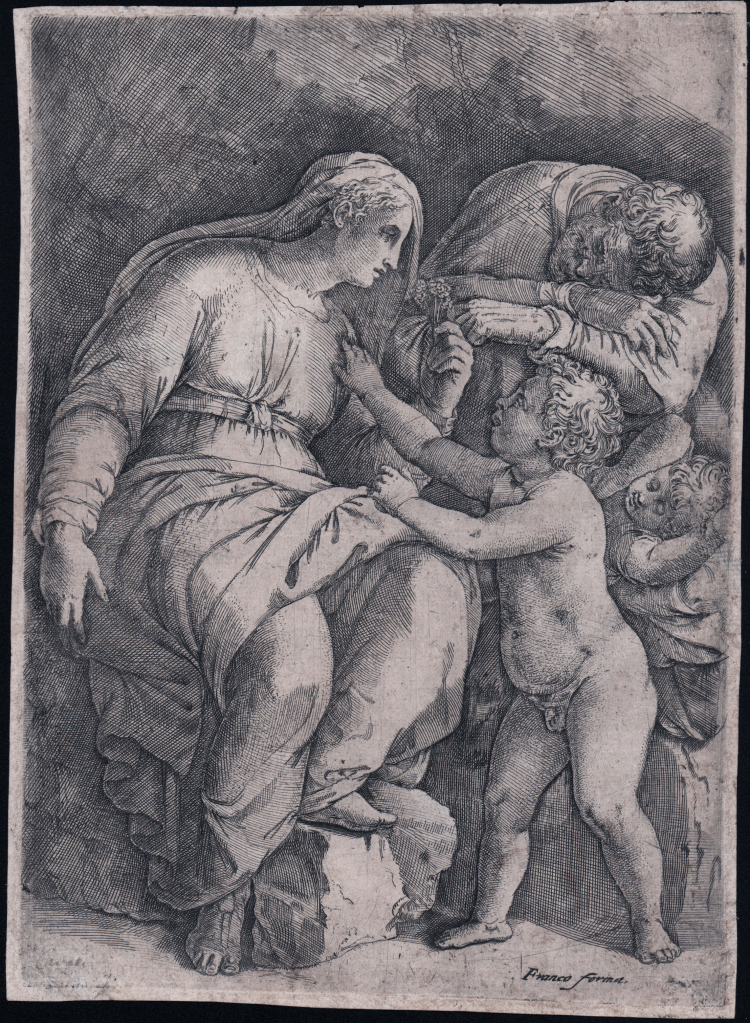




| Reference: | S41941 |
| Author | Giovanni Battista FRANCO |
| Year: | 1550 ca. |
| Measures: | 182 x 252 mm |



| Reference: | S41941 |
| Author | Giovanni Battista FRANCO |
| Year: | 1550 ca. |
| Measures: | 182 x 252 mm |
Etching and engraving, inscribed with publisher's address lower right: 'Franco forma'. Example in the second state, of two, with publisher’s note.
Engraved by Giovanni Battista Franco and published by Giacomo Franco.
“Le figure monumentali sono le uniche protagoniste di questa composizione, in cui lo sfondo paesaggistico così caro alla produzione del Franco, viene annullato e sostituito con giochi chiaroscurali costruiti all’acquaforte, che permettono il massimo risalto delle immagini. Queste, intensamente illuminate, tendono a proiettarsi verso l’esterno, e la loro chiarezza disegnativa permette di identificarli come exempla stilistici, destinati alla conoscenza e all’imitazione.” Cf. R. D’Amico, Incisori Veneti dal XV al XVIII secolo, p. 48, n. 189
Good example, printed on contemporary laid paper, with “circle with letters DM surmounted by trefoil” watermark, thin margins in good condition.
|
Bartsch XVI.128.27; TIB 32, p. 183 n. 27; Incisori veneti dal XV al XVIII secolo, p. 48 n. 189.
|
Giovanni Battista FRANCO (Udine 1510 – Venezia 1580)
|
Battista Franco dei Franchi, also known as Semoleo or Semolei, was engraver, drawer, painter and etcher; he was born and he died in Venice, as recorded on official documents.
Franco worked in Rome, Florence and Urbino, where he met and started loving Italian Mannerism. While in Rome, he engraved many subjects from Michelangelo, his favourite artist; according to Vasari, he also engraved a magnificent Giudizio Universale.
For sure Franco knew the frescoes of the Vatican, for in many prints we can see the influence of paintings such as Giulio Romano’s Donazione di Costantino. Romano was a real source of inspiration for Franco, for both in Rome and Mantua he worked on his subjects, as it can be seen in the frescoes of the Tè.
In 1552 he went back to Venice, where he lived till his death; he worked for the Libreria Marciana (1556) and on the vault of the Golden Staircase in the Palazzo Ducale, before starting the decoration of Villa Foscari. In the decoration of the Villa is once again clear the influence of Michelangelo. He engraved and signed about 100 plates, with the monogram, BF or BFVF (Battista Franco venetiano fecit), whose style is very close to that of Giulio Bonasone.
Bartsch lists 93 engravings of this artist, Passavant 98.
|
|
Bartsch XVI.128.27; TIB 32, p. 183 n. 27; Incisori veneti dal XV al XVIII secolo, p. 48 n. 189.
|
Giovanni Battista FRANCO (Udine 1510 – Venezia 1580)
|
Battista Franco dei Franchi, also known as Semoleo or Semolei, was engraver, drawer, painter and etcher; he was born and he died in Venice, as recorded on official documents.
Franco worked in Rome, Florence and Urbino, where he met and started loving Italian Mannerism. While in Rome, he engraved many subjects from Michelangelo, his favourite artist; according to Vasari, he also engraved a magnificent Giudizio Universale.
For sure Franco knew the frescoes of the Vatican, for in many prints we can see the influence of paintings such as Giulio Romano’s Donazione di Costantino. Romano was a real source of inspiration for Franco, for both in Rome and Mantua he worked on his subjects, as it can be seen in the frescoes of the Tè.
In 1552 he went back to Venice, where he lived till his death; he worked for the Libreria Marciana (1556) and on the vault of the Golden Staircase in the Palazzo Ducale, before starting the decoration of Villa Foscari. In the decoration of the Villa is once again clear the influence of Michelangelo. He engraved and signed about 100 plates, with the monogram, BF or BFVF (Battista Franco venetiano fecit), whose style is very close to that of Giulio Bonasone.
Bartsch lists 93 engravings of this artist, Passavant 98.
|